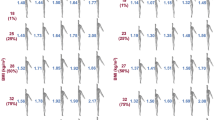Abstract
Thermo-neutrality is one of the major environmental factors affecting a premature or low-birth-weight neonate inside an incubator. Severe temperature differences inside an incubator lead to neonate heat loss, hypothermia and apnoea, which are closely related to air flow and air velocity. In the study, flow visualisations, hot-wire velocity measurements and computational fluid dynamics simulate the airflow inside a neonatal incubator. An anatomically correct neonate model is designed using a three-dimensional laser scanner system and a rapid prototyping machine. Flow visualisations demonstrate that large-scale rotating airflow is produced inside the chamber, and a number of small, stationary eddies are found in regions between the air inlet and the neonate. Hot-wire measurements show that air velocities along the long inlets are not uniform. Computational fluid dynamics show relatively uniform temperatures of about 34°C on the neonate's anterior aspect and the highest temperature of 36.1°C at the right armpit and the crotch. Flow fields from airflow visualisations, hot-wire measurements and computational fluid dynamics are very similar, both qualitatively and quantitatively. The small eddies produced between the neonate and the mattress could interfere with convective and evaporative heat transfers from the neonate. Therefore it is important to eliminate eddies around the neonate in future designs of neonatal incubators.
Similar content being viewed by others
References
Bell, E. F. (1983): ‘Infant incubators and radiant warmers’,Early Hum. Dev.,8, pp. 351–375
Bell, E. F., andRios, G. R. (1983): ‘A double-walled incubator alters the partition of body heat loss of premature infants’,Pediatr. Res.,17, pp. 135–140
Faranoff, A. A., Wald, M., Gruber, H. S., andKraus, M. H. (1972): ‘Insensible water loss in low birth weight infants’,Pediatrics,50, pp. 236–245
Hasegawa, T., Horio, H., Okino, H., Taylor, T. W., andYamaguchi, T. (1993): ‘Three-dimensional visualization of air flow in infant incubators using computational fluid mechanics’,Biomed. Instrum. Technol., pp. 311–317
Hey, E. N. (1966): ‘Temperature control in incubators’,Lancet,2, p. 202
Hey E. N. (1969): ‘The relation between environmental temperature and oxygen consumption in the newborn baby’,J. Physiol. 200, pp. 589–603
Hey, E. N., andKatz, G. (1970): ‘The optimum thermal environment for naked babies’,Arch. Dis. Child.,45, pp. 328–334
Hey, E. N., andMount, L. E. (1972): ‘Heat losses from babies in incubators’,Arch. Dis. Child.,42, pp. 75–84
Johnson, A. T. (1991): ‘Biomechanics and exercise physiology’ (Wiley & Sons), pp. 361–368
Levene, M. I., Tudehope, D. I., andThearle, M. J. (2000): ‘Essentials of neonatal medicine, 3rd edn’ (Blackwell Science, 2000), pp. 89–90
Libert, J. P., Bach, V., andFarges, G. (1997): ‘Neural temperature range in incubators: performance of equipment in current use and new developments’,Crit. Rev. Biomed. Eng.,25, pp. 287–370
Okken, A., Blijham, C., Franz, W., andBohn, E. (1982): ‘Effects of forced convection of heated air on insensible water loss and heat loss in preterm infants in incubators’,J. Pediatr.,101, pp. 108–112
Perlstein, P. H., Edwards, N. K., Atherton H. D., andSutherland, J. M. (1976): ‘Computer-assisted newborn intensive care’,Pediatrics,57, pp. 494–502
Perlstein, P. H., Edwards, N. K., andSutherland, J. M. (1970): ‘Apnea in premature infants and incubator-air-temperature changes’,N. Engl. J. Med.,282, pp. 461–466
Sarman, I., Bolin, A., Holmer, I., andTunell, R. (1992): ‘Assessment of thermal conditions in neonatal care: use of a manikin of premature baby size’,Am. J. Perinatol.,9, pp. 239–246
Stothers, J. K. (1980): ‘The effect of forced convection on neonatal heat loss’,J. Physiol.,305, p. 77
Stothers, J. K., andWarner, R. M. (1984): ‘Thermal balance and sleep state in the newborn’,Early Hum. Dev.,9, pp. 313–322
Telliez, F., Bach, V., Delanand, S., Bouferrache, B., Krim, G., andLibert, J. P. (1997): ‘Skin derivative control of thermal environment in a closed incubator’,Med. Biol. Eng. Comput.,35, pp. 521–527
Thompson, M. H., Stothers, J. K., andMcLellan, N. J. (1984): ‘Weight and water loss in the neonate in natural and forced convection’,Arch. Disease Childhood,59, pp. 951–956
Van Doormal, J. P., andRaithby, G. D. (1984): ‘Enhancements of the SIMPLE method for predicting incompressible fluid flows’,Numerical Heat Transfer,7, pp. 147–163
Yamaguchi, T., Taylor, T. W., Okino, H., Horio, H., andHasegawa, T. (1996): ‘Computational fluid mechanical study of the convective heat transfer in a closed space simulating an infant incubator’,Frontiers Med. Biol. Eng.,7, pp. 129–141
Author information
Authors and Affiliations
Corresponding author
Rights and permissions
About this article
Cite this article
Kim, Y.H., Kwon, C.H. & Yoo, S.C. Experimental and numerical studies on convective heat transfer in a neonatal incubator. Med. Biol. Eng. Comput. 40, 114–121 (2002). https://doi.org/10.1007/BF02347704
Received:
Accepted:
Issue Date:
DOI: https://doi.org/10.1007/BF02347704




